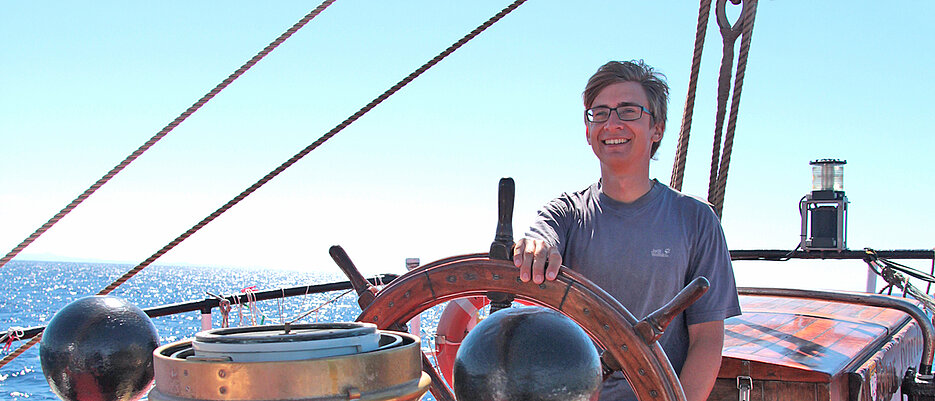From Würzburg into the world
07/31/2018Sven Heinrich studied geography at the University of Würzburg. Today, he is a permanent crew member of the "Thor Heyerdahl" sail training ship.
Which jobs do graduates from the University of Würzburg work in? To present different perspectives to students, Michaela Thiel, the director of the central alumni network, interviews selected alumni. This time, it is Sven Heinrich's turn.
Alumnus Sven Heinrich is a geographer from the University of Würzburg. He now joins the master's programme "Geophysics" in Kiel, Germany, and is cruising the oceans of the world on board the sail training ship "Thor Heyerdahl".
Mr. Heinrich, how did you "end up on the ship"? The Thor Heyerdahl is a sail training ship run by volunteers which was completely overhauled between 2007 and 2009. I got on board through my mother who sailed on the ship when she was a student and by answering the call to help restore the vessel. Since 2012, after a training cruise on board, I have been a permanent crew member. If you are interested in learning more about this traditional sailing ship, visit our homepage.
What is your typical day like on board the Thor Heyerdahl? My daily routine is determined by my watch schedule. A sailing ship sails day and night. So the 24 hours of the day are divided into three or four watches so that you are on watch twice for three or four hours each day. During this time, you take care of everything to make sure the ship runs safely. The rest of the time, you are off-watch. During this time, you eat, sleep, work on the ship or just enjoy sailing.
Before joining the Thor Heyerdahl, you were cruising on the "Sonne" (German for 'Sun') research vessel. What did you do there? The trip took me from Darwin along the Australian West Coast to Fremantle for 22 days. Our mission was to collect sediment cores from previously selected areas. These core samples are later subjected to chemical and geoscientific examinations to reconstruct the climatic history of West Australia over the past 200,000 years. The paleoclimatic data are used to test hypotheses to get a better understanding of Earth's climate.
And what was our daily routine like there? The day on a research ship is also governed by the watch schedule. It was my job together with my boss and another master's student to monitor the seismic and acoustic equipment on board and to analyse the collected measurement data. To do this, we were alternately on watch for four hours.
What happens during a storm? On a research vessel the size of the "Sonne", few precautions are necessary because the permanent crew does everything and the ship is very stable owing to its sheer size and additional aids. If you are new on a ship, you have to get used to the fact that everything moves around and you have to secure your stuff with non-skid mats.
And on the Thor Heyerdahl? This is totally different on the Thor Heyerdahl. If a storm or heavy weather comes up, as a member of the permanent crew I am responsible for preparing the ship for the storm. This includes securing everything on and below deck, adjusting the sail area to the wind speed by reducing the sail area and adjusting the course if necessary.
Can you describe one of your best moments to us? On the "Sonne", the best thing was to marvel at the Milky Way and shooting starts before or after my watch on the "monkey island", the highest accessible point on the ship. For the "Thor Heyerdahl" this is more difficult to answer. The whole trip was very impressive and exciting so that there was no "one best moment". Some of the highlights included dolphins riding with the bow wave, bioluminescence, sailing over the Atlantic Ocean, surfing and snorkelling in Panama...the list could be continued endlessly. Also, the human encounters and relationships during the trip were great experiences.
Thank you for the interview.
If you want to learn more about the alumni network of the University of Würzburg or to register, follow the link below.







